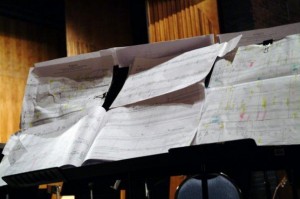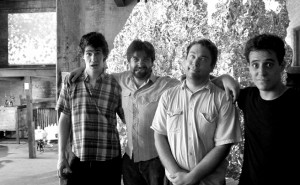[youtube]http://www.youtube.com/watch?v=klmhgRRRnHM[/youtube]
A nanosecond or two ago–at the dawning of the age of aquarius, when my generation’s future was still a bright crazy quilt of dreams and possibilities–my wife Suzanne and I were graduate students at West Virginia University in Morgantown. I had just successfully avoided Viet Nam by signing up for two years of active duty in the Navy Reserve and accidentally getting myself assigned to duty on an icebreaker. I spent most of my contribution to the war effort at McMurdo Sound, Antarctica, staving off death by boredom by feeding beer to penguins who, as my shipmates and I soon learned, make nasty and argumentative, yet amusing, drunks. I later spent several months on the same ship in the Barents Sea spying on the Russians and hoping that the Badgers that came barreling at the ship four or five times a day about 100 feet off the water, sometimes opening their bomb doors, were not serious. I’m sure the Russian pilots thought it was at least as amusing as giving beer to penguins.
In the summer of 1967, my service as a floating office worker and sometime typist for the CIA, having been completed, we moved to Morgantown and settled into a cheap apartment above a downtown flower shop on Pine Street. Suzanne was a graduate assistant in the art department, I was a “gradass” in journalism. We each got paid a couple of hundred dollars a month, free tuition, and I got a regular check under the GI Bill. We had it made but, of course, we didn’t know it at the time.
One day Suzanne introduced me to a thin, bearded, bushy-haired guy named John Vaughan who was picking up a few extra bucks each week by sitting around in a jock strap in one of her drawing classes while art students drew his anatomy. He looked a lot like the image of Jesus that we all know and love but then all the young dudes looked like Jesus in those days. “You’ve got to come hear the band I play with,” he said. “We’re pretty good.” And so a couple of days later we made our way to a grungy joint called Mother Witherspoon’s to hear the Mind Garage, as the band was called. It was the closest thing I’ve ever had to a religious experience. As soon as the five-member band hit the stage and lit into a psychedelic arrangement of Sam & Dave’s “Hold On, I’m Comin'” the place quickly turned into pure pandemonium. Here were five musicians who were symbiotically joined at the hip. They played mainly covers, true, but they understood dynamics in a way that most acid bands of the period didn’t so even covers became original. They knew when to play loud and when to play soft. They were garage band and musically sophisticated at the same time.
A few days later, I wrote a somewhat pretentious, but very enthusiastic, review of the band for the student newspaper which, alas, Larry McClurg, their terrific lead singer and web archivist has seen fit to preserve for posterity here. (The headshot alone is worth the trip.) I don’t think Suzanne and I missed a performance after that first night until we left Morgantown to come to New York (or, in truth, to an apartment we could afford on Staten Island which though technically part of New York City really isn’t) in the fall of 1967. By then I knew the Mind Garage had been encouraged by an Episcopal minister named Michael Paine and his wife to write a rock church service and that it was almost finished. I didn’t know about it at the time but that piece–the Electric Liturgy–was first performed at Trinity Episcopal Church in Morgantown on March 10, 1968. It was the first live Christian Rock worship service ever–basically, what Catholics’ would call a “Mass.” The band performed it live at several other churches in the following months, including at St Stephens of the Incarnation Episcopal Church in Washington, DC and at Princeton University. In April, 1969, the band performed the first nationally televised rock and roll worship service from New York on ABC TV.
Some time in late June 1968 I ran across a piece in the Village Voice by the then arts editor Diane Fisher, a fellow West Virginian, lamenting the fact that she has just been in Morgantown and there was no music scene there. I dashed off an “au contraire” note, with a copy of my review. About a week later, she called me to tell me she had learned that the Mind Garage was performing the mass at St. Mark’s in the Bowery in a couple of weeks. After the St. Mark’s performance (which was terrific, by the way), Annie did an enthusiastic review, generously quoting my silly college review and giving me credit for turning her on to the Mind Garage. It helped me get a freelance writing career going and I’m sure it helped the band land a contract with RCA, for whom they did a couple of albums, before breaking up and fading back into real life in 1970.
What none of us realized at the time was that they were accidentally making history, inventing a musical genre that has become a multi-million dollar business, although the band never made much money at it. (They performed all of the services at churches for free and never really had a big hit.)
A couple of band members managed to go on and build careers as musicians but Larry McClurg, almost singlehandedly, has kept the Mind Garage faith all these years and still believes that there could still be a future for the group. Thanks to Facebook and the web page Larry maintains, the group has more fans today than they did in 1970. There was an outdoor reunion concert in West Virginia in 2007 and there is a new recording of the Electric Liturgy, complete with words and background, available for free download here. There is a petition you should sign and send to the Rock n’ Roll Hall of Fame.
Like so many of us (and here I include myself) who were young in the sixties and had what the horse players call “cheap speed,” too much opportunity before we were ready for it proved to be a curse. I hope Larry is right and there will be a new beginning for the Mind Garage. As for me I’ve already gone through the list of projects I never started or never finished and narrowed it down to the three or four I want to spend the rest of my life not starting or not finishing.
But, as I sit here writing this, my fellow traveler for the past 46 years, now gravely ill, asleep nearby, I can almost conjure up the sense of joy that the two of us shared on that night nearly 50 years ago when we heard the Mind Garage for the first time at Mother Witherspoon’s. Listening to the YouTube video above, my heart did a little dance for the first time in a long time. Thanks Larry and Jack and Norris and Teddy and John. I owe you.
 Andrew Raffo Dewar (b.1975 Rosario, Argentina) is an Assistant Professor in New College at the University of Alabama. He’s a composer, improviser, soprano saxophonist and ethnomusicologist. He’s studied and/or performed with Steve Lacy, Anthony Braxton, Bill Dixon, Alvin Lucier, and Milo Fine. He has also had a long involvement with Indonesian traditional and experimental music. His work has been performed by the Flux Quartet, the Koto Phase ensemble and Sekar Anu. As an improviser and performer Andrew has shared the stage with a plethora of musicians worldwide, both the celebrated and the little-known.
Andrew Raffo Dewar (b.1975 Rosario, Argentina) is an Assistant Professor in New College at the University of Alabama. He’s a composer, improviser, soprano saxophonist and ethnomusicologist. He’s studied and/or performed with Steve Lacy, Anthony Braxton, Bill Dixon, Alvin Lucier, and Milo Fine. He has also had a long involvement with Indonesian traditional and experimental music. His work has been performed by the Flux Quartet, the Koto Phase ensemble and Sekar Anu. As an improviser and performer Andrew has shared the stage with a plethora of musicians worldwide, both the celebrated and the little-known.


